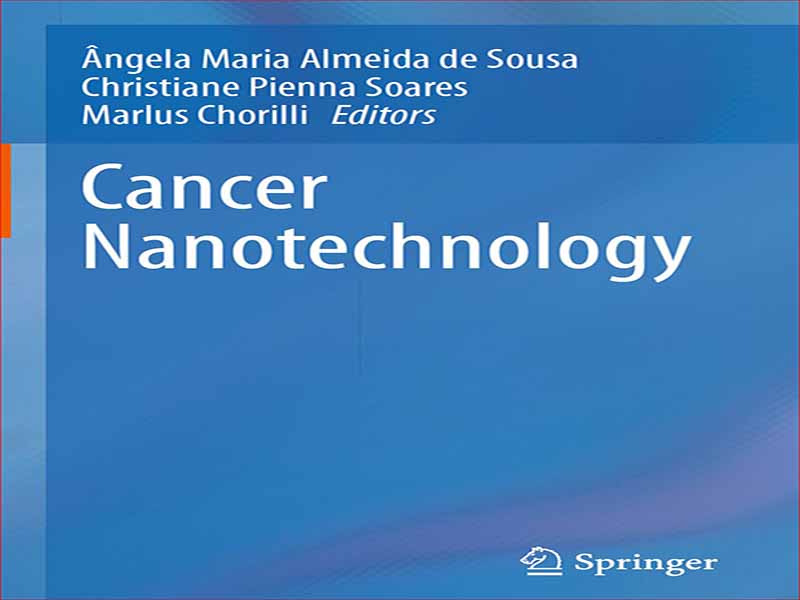- عنوان کتاب: Cancer Nanotechnology
- نویسنده: Ângela Maria Almeida de Sousa
- حوزه: نانو دارو, درمان سرطان
- سال انتشار: 2023
- تعداد صفحه: 386
- زبان اصلی: انگلیسی
- نوع فایل: pdf
- حجم فایل: 13.7 مگابایت
سرطان همچنان یکی از علل اصلی مرگ و میر در سراسر جهان، هم در کشورهای توسعه یافته و هم در کشورهای در حال توسعه است. ممکن است افراد در هر سنی، حتی جنین ها را تحت تاثیر قرار دهد، اما خطر ابتلا به اکثر انواع سرطان با افزایش سن افزایش می یابد. رویکردهای درمانی کنونی، که شامل جراحی، شیمی درمانی و رادیوتراپی میشود، با عوارض جانبی نامطلوب ناشی از عدم اختصاصیت درمانی برای سلولها یا بافتهای تومور همراه است. نانوبیوداروها حوزه ای است که عوامل درمانی مبتنی بر فناوری نانو و سیستم های دارورسانی را مطالعه می کند. داروها، اسیدهای نوکلئیک، پپتیدها، پروتئینها، آنتیبادیها و مولکولهای کوچک را میتوان در رویکردهای درمانی سرطان مورد استفاده قرار داد و اثر آنها در صورت تحویل در نانوحاملها تقویت میشود. توانایی تمایز سلولهای بدخیم از سلولهای غیر بدخیم و ریشهکنی انتخابی سلولهای بدخیم نقش اصلی نانوتکنولوژی در ارتباط با درمان سرطان است. علاوه بر این، تغییرات اپی ژنتیکی غیرطبیعی نقش مهمی در توسعه سرطان ایفا می کند. به این ترتیب، نانوتکنولوژی میتواند اهداف مؤثری برای پیشآگهی سرطان (به عنوان مدلهایی در درک توسعه سرطان)، تشخیص (به عنوان داربست برای ارزیابی متاستازها) و درمان تحت رویکردهای مختلف فراهم کند. تحویل دارو به عنوان یک کاربرد زیست پزشکی در درمان سرطان یک استراتژی به طور گسترده مورد بررسی قرار گرفته است. نانوسیستمها و نانوساختارهای مبتنی بر طیف گستردهای از مواد (مانند لیپید، پلیمر، معدنی و غیره) برای بارگذاری/کپسولهسازی داروها و در عین حال ترویج انتشار هدفمند و سفارشی/کنترلشده آنها استفاده شدهاند. در تعقیب این هدف، دانشمندان توجه خود را بر مفهوم سیستمهای پاسخدهنده به محرک، قابل تنظیم، چندهدفمند و ارسال کد بهعنوان ابزاری قدرتمند برای رساندن مولکولهای درمانی به محل عمل خود متمرکز کردهاند. چندین استراتژی نوآورانه مبتنی بر تحویل آنتیبادیهای مونوکلونال، پروتئینها و پپتیدها با توسل به فناوری نانو برای درمان مؤثر سرطان توسعه داده شدهاند. یک رویکرد نسبتاً جدید برای درمان سرطان شامل استفاده از یک فرآیند طبیعی است که در آن اسیدهای نوکلئیک کد کننده یا غیر کدکننده می توانند بیان ژن را تنظیم کنند. ژن درمانی برای بازآرایی ژنهای مختلف و دستکاری عملکرد آنها بررسی شده است تا اطلاعات لازم برای اصلاح ژن، سنتز پروتئین و مکملسازی و همچنین تنظیم مکانیسمهای سلولی را فراهم کند. ژن درمانی میتوکندری به عنوان یک فناوری هیجان انگیز و امیدوارکننده برای اصلاح جهش های DNA میتوکندری، با جایگزینی ژن های جهش یافته، ظاهر می شود، بنابراین عملکرد طبیعی میتوکندری را بازیابی می کند. خاموش کردن ژن با استفاده از مولکولهای کوچک RNA، توانایی قوی در خاموش کردن عوامل انکوژنیک را نشان میدهد، به عنوان یکی از مهمترین پیشرفتها و زمینههای رو به رشد سریع در علم محسوب میشود و به عنوان یک رویکرد درمانی در برابر سرطان و پیشرفت آن به سمت متاستاز استفاده میشود. علاوه بر این، ترکیب نانوتکنولوژی با کرونوبیولوژی برای تنظیم دارو و/یا ژن بر اساس ریتم شبانه روزی هر بیمار به عنوان یک دیدگاه منحصر به فرد و اصلی در کرونوتراپی شخصی سرطان پدیدار می شود. رویکرد دیگر، واکسیناسیون انسانی با استفاده از نانوسیستمها بهعنوان تقویتکننده ایمنی و وسایل انتقال دهنده است که قادر به ایجاد ایمنی هومورال و سلولی در برابر سرطان هستند. نانوواکسنها به عنوان روششناسی واکسیناسیون در مقیاس نانو مشخص شدهاند که میتواند تحریک چندین سلول سیستم ایمنی و مولکولهای تعدیلکننده ایمنی را برای ایجاد یک ایمنی ضد توموری قوی بهبود بخشد. برای درمان موثر، تکنیک های تشخیصی و درمانی بهبود یافته با حداقل عوارض جانبی مورد نیاز است. یک روند در حال ظهور در این جهت ترانوستیک است که نشان دهنده یک تشخیص ترکیبی و رویکرد درمانی برای بیماری سرطان است و هدف آن حذف روش های چند مرحله ای، کاهش تاخیر در درمان و بهبود مراقبت از بیمار است. نانوذرات، از جمله نانو کریستالهای نیمهرسانای فلورسنت (نقاط کوانتومی) و نانوذرات مغناطیسی، خواص عالی خود را برای تکنیکهای تصویربرداری in vivo در تعدادی از مدالیتهها مانند رزونانس مغناطیسی و تصویربرداری فلورسانس ثابت کردهاند. نانو فتوتراپی ها (یعنی درمان های نانو فتوترمال، نانوفتوشیمیایی و نانوفتوایمونولوژیک) نیز با القای فعال شدن موضعی عوامل نوردرمانی غیر سمی بر اثر تابش نور، پتانسیل قوی برای درمان سرطان دارند. برخی از دستگاههای نوآورانه مانند میکروسوزنها برای افزایش کاربردهای درمان سرطان در حال توسعه هستند. به طور کلی، این کتاب مروری بر تحقیقات و نوآوریها در مورد قویترین درمانهای سرطان با تمرکز بر نقش نانوتکنولوژی به عنوان ابزاری قدرتمند در تشخیص، تصویربرداری و درمان سرطان با هدف توسعه روشهای کارآمد، خاص و غیرتهاجمی برای بازیابی سرطان ارائه میکند. سلامتی و رفاه همه بیماران سرطانی.
Cancer remains one of the leading causes of death worldwide, both in developed and in developing nations. It may affect people of all ages, even fetuses, but the risk for most cancer varieties increases with age. Current therapeutic approaches, which include surgery, chemotherapy, and radiotherapy, are associated with adverse side effects, arising from the lack of therapy specificity for tumor cells or tissues. Nanobiopharmaceuticals is the area that studies nanotechnology-based therapeutic agents and drug delivery systems. Drugs, nucleic acids, peptides, proteins, antibod¬ies, and small molecules can be used in cancer therapeutic approaches, and their effect is potentiated when delivered in nanocarriers. The ability to differentiate malignant cells from nonmalignant cells and to selectively eradicate malignant cells is the central role of nanotechnology as it relates to cancer treatment. Moreover, abnormal epigenetic changes play a critical role in cancer development. In this way, nanotechnology can provide effective targets for cancer prognosis (contributing as models to understanding cancer development), diagnosis (as scaffolds to evaluate metastases), and therapy under different approaches.
Drug delivery is a widely explored strategy as a biomedical application in cancer therapy. Nanosystems and nanostructures based on a broad variety of materials (such as lipidic, polymeric, inorganic, among others) have been used to load/encap¬sulate drugs while promoting their targeted and tailored/controlled release. Pursuing this goal, scientists have focused their attention on the conception of stimuli-responsive, tunable, multitargeted, and codelivery systems as a powerful tool to deliver therapeutic molecules to their site of action. Several innovative strategies based on the delivery of monoclonal antibodies, proteins, and peptides resorting to nanotechnology have been developed for efficient cancer therapy. A relatively recent approach to cancer therapy involves the use of a natural process wherein cod¬ing or noncoding nucleic acids can regulate gene expression. Gene therapy has been explored to rearrange different genes and manipulate their functions providing the necessary information for gene correction, protein synthesis, and supplementation as well as for regulation of cell mechanisms. Mitochondrial gene therapy emerges as an exciting and promising technology to correct mitochondrial DNA mutations, by replacing mutated genes, therefore restoring the normal mitochondrial function. Gene silencing using small RNA molecules shows potent ability in silencing onco¬genic factors, has been considered as one of the most important breakthroughs and rapidly growing fields in science, and is used as a therapeutic approach against cancer and its progression to metastasis. Additionally, the combination of nanotech¬nology with chronobiology to adjust drug and/or gene delivery according to each patient’s individual circadian rhythm emerges as a unique and original perspective in personalized cancer chronotherapy. Another approach is the human vaccination making use of nanosystems as immunopotentiators and delivery vehicles capable of eliciting humoral and cellular immunity against cancer. Nanovaccines have been characterized as methodologies of vaccination at the nanoscale, which could improve the stimulation of several immune system cells and immunomodulatory molecules to generate a potent antitumor immunity.
For an effective treatment, improved diagnostic and therapeutic techniques with minimal side-effects are required. An emerging trend in this direction is theranostics which represents a combinatorial diagnosis and therapeutic approach to cancer dis¬ease and aims to eliminate multistep procedures, reduce delays in treatment, and improves patient care. Nanoparticles, including fluorescent semiconductor nano¬crystals (quantum dots) and magnetic nanoparticles, have proven their excellent properties for in vivo imaging techniques in a number of modalities such as mag¬netic resonance and fluorescence imaging, respectively. Nano-phototherapies (namely nano-photothermal, nano-photochemical, and nano-photoimmunological therapies) also bring strong potential for cancer treatment by inducing the local activation of nontoxic phototherapeutic agents upon light irradiation. Some innova¬tive devices, such as microneedles, are in development to enhance cancer therapy applications.
Overall, this book presents an overview of research and innovation about the most potent cancer therapies, focusing on the role of nanotechnology as a powerful tool in diagnosis, imaging, and cancer treatment aiming to develop efficient, spe¬cific, and noninvasive approaches to restore the health and well-being of all cancer patients.
این کتاب را میتوانید از لینک زیر بصورت رایگان دانلود کنید:
Download: Cancer Nanotechnology

































نظرات کاربران